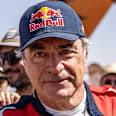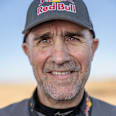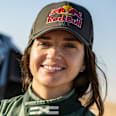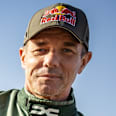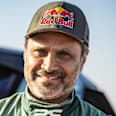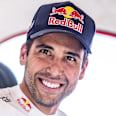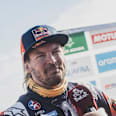
Rally Raid
After 12 punishing stages and more than 8,000km raced, the 2024 Dakar Rally is over and more history has been made. Here's what you need to know about what went down in the Saudi Arabian desert.
Summary
- 1'El Matador' makes history – and aces camping under the stars
- 2A marathon marathon stage
- 3Five-star desert assistance
- 4The first woman in two decades lifts the Dakar trophy
- 5Remarkable results for a Dakar rookie
- 6The return of the Bull
- 7Dakar's fastest brothers
- 8The ultimate '80s tribute act
- 9Held up by pirates
- 10From Dakar to Duckcar – meet the crazy Classics
The 2024 Dakar Rally was one of the toughest Dakars in the event’s long history and one that pushed its competitors to the limit. Carlos Sainz masterminded a brilliant Car win for Audi, while T3 champion Cristina Gutiérrez became only the second woman to lift the Touraeg winner’s trophy.
The Dakar Rally crams the race distance of an entire season of WRC into a two-week marathon that pushes its stars to the limit. It pits 778 cars, bikes, buggies and trucks against nearly 8,000km of rugged Saudi Arabian terrain. Here’s some stories from along the route that you may have missed.
01
'El Matador' makes history – and aces camping under the stars
Carlos Sainz and Lucas Cruz won the Dakar for the fourth time without winning any of the individual stages. 'El Matador's' consistency was key to the victory, plus the support he received on the stages from his wingmen Stéphane Peterhansel and Mattias Ekström.
On the way to victory this year, he overcame 11 punctures and two nights sleeping under the stars in a tiny tent. At 61, the Spaniard is the oldest Dakar winner and the first to win the Car category in an electric hybrid vehicle – the Audi RS Q e-tron. Each of his four Dakar titles to date has come with a different manufacturer: Volkswagen in 2010, Peugeot in 2018, Mini in 2020 and now Audi.

02
A marathon marathon stage
This was the 46th Dakar Rally and the great event continues to grow, adding more categories and encouraging entries using alternative fuels and ground-breaking tech. But it also evolves to present a bigger sporting challenge to some of the greatest racers in the world. This year, Race director David Castera excelled himself with the 48Hr Chrono – an unprecedented marathon stage that took the Dakarists deep into the 1,000km long and 500km wide Empty Quarter during two days of navigating over towering sand dunes.
Get the lowdown on surviving the marathon stage with Challenger class champ Cristina Gutiérrez below:

Day one gave the competitors until 4pm to get as far as they could along the 766km route, before pulling into one of eight temporary bivouacs dotted along the stage. They were permitted to make what repairs they could with the kits provided before dining under the stars on military rations and sleeping on sand in pop-up tents. The next day, they had to complete the second leg of the stage before collapsing in a heap for rest day.
Sébastien Loeb and Adrian van Beveren both emerged from the desert on top, but the mighty stage clamed some impressive scalps, effectively knocking Monsieur Dakar himself, Stéphane Peterhansel, out of contention, along with defending champion Nasser Al-Attiyah, rally leader Razeed Al-Rajhi and Skyler Howes and Joan Barreda in the Bikes.
03
Five-star desert assistance
When the battery has gone on your bike halfway through the longest-ever timed stage and you face a ride over hundreds of kilometers of dunes of the ominous-sounding Empty Quarter, you need help from an expert. Step forward Nasser Al-Attiyah, who got to work tinkering with Mason Klein’s Kove bike in the oasis of tiny tents that made up the mid-point of the 48hr Chrono. Eventually the five-time champion helped with an old- fashioned push start to send the American on his way.
04
The first woman in two decades lifts the Dakar trophy
Cristina Gutiérrez became the first woman to win the Dakar Rally since Jutta Kleinschmidt at the turn of the century. Applying the rule ‘To finish first, first you have to finish’ to exemplary standards, she produced the perfect strategy to be completing the last stage with second place wrapped up. However, disaster struck stable-mate and race leader Mitch Guthrie Jr., when his Taurus developed an engine problem, stalling the American’s charge by 40 minutes.
Unaware that she was the champ, Gutiérrez crossed the line and ultimately took top step in her last run in the Challenger class. Next year, she begins a new chapter by joining Sébastien Loeb and Nasser Al-Attiyah in Renault’s new Dacia team, with cars prepped by Prodrive.
05
Remarkable results for a Dakar rookie
Bike class competitor Tobias Ebster brought the bivouac to its feet as he finished ninth overall on Stage 5, winning the Rally2 category and the Originals class. It was the first time an Original rider had finished inside the top 10. On the front foot, the Austrian continued to blaze a trail and won the Originals race.
Across the Dakar, no one has it tougher than the Originals. Formerly known as the Malle Moto category, they race to the format designed by Paris-Dakar founder Thierry Sabine. His vision was to race from Paris, through the Sahara desert to Dakar in Senegal, camping out under the night sky, making his own repairs and eating military rations. No team support, no catering and no motorhomes. The Originals are a close-knit group who have carried the Spirit of the Dakar proudly around the world.
What made the result all the more remarkable is that Ebster is a Dakar rookie. He’s also the nephew of KTM legend Heinz Kinigadner, who came agonizingly close to victory at this event, so the result lays a family hoodoo to rest. “It was such a big adventure, it was so tough. It was so rough. It’s the toughest rally in the world,” said Ebster. “I love it, I enjoyed every moment. I had so much fun.”
Find out more about Tobias Ebster's Dakar Rally journey in Episode 5 of In the Dust:

06
The return of the Bull
A wonderful cameo from one of the most eccentric Dakar creations. Dutchman Gerard de Rooy took a route one approach to racing: the more power, the better. It had worked in the short sprints of rallycross, why not the ultimate endurance race? So, he took a DAF 3300 truck and welded another truck to the back of it to create the all-wheel drive, twin-cab Bull that raced in the 1985 edition. With two turbo-charged 600hp engines, one for the front and one for the rear axle, it was capable of 200kph. In 1988, one of its successors was even seen overtaking Ari Vatanen in the mighty Peugeot 405 T16.
This year, it returned with Jaanus Kasteren Sr at the helm (his son led the charge in the trucks for the De Rooy Team) and finished a respectable 57th in the Classic category.
07
Dakar's fastest brothers
Another first at the Dakar Rally, as brothers Kevin and Luciano Benavides finished first and second in a stage. It was a highlight in what had been a difficult Dakar for KTM, Husqvarna and GasGas team riders, where the Honda riders took a grip of the rally from the start.
On Stage 8 however the Argentinian siblings led the way to seal a famous 1-2, with Dakar champion Kevin in first place and his Rally Raid world champion younger brother Luciano in second. They shared the podium again on the final leg, with another two-time champ, Toby Price, the filling in the sandwich in P2 and they’ll be revved up for the return in 2025.
Get to know speedy siblings better in Episode 3 of In the Dust below:

08
The ultimate '80s tribute act
In the mid-1980s, Le Mans legend and F1 winner Jacky Ickx persuaded Porsche to design a car capable of winning the Dakar. The result was the famed 959, which the Belgian’s team-mate René Metge took to victory in 1986, with Ickx second. Flash forward to 2024 and the husband and wife team of Juan Morera and Lidia Ruba chose to defend their crown in the Classics in a replica 959 Porsche: their’s styled after Ickx’s car and their friends Frederic Larre and Jeremy Athimon in a copy of Metge’s winning car. They finished a respectable P6 and P18 in the Classics race in a tribute that took on greater meaning after Metge, who was a former Dakar racing director, died a couple of days before the start.
09
Held up by pirates
Rodrigo Varela and Enio Bozzano had to go shopping for a new buggy after theirs was held up by pirates as it tried to come through the Red Sea. The cargo ship carrying the Brazilians’ Can-Am UTV to the Dakar managed to escape the pirates, but had to divert and would arrive in Saudi Arabia 20 days late. They managed to track down a racing spec Can-Am in Portugal. “But we had to make modifications and adaptations in a hurry,” Varela explained. “Fortunately, it worked and we passed the Dakar inspection.”
10
From Dakar to Duckcar – meet the crazy Classics
The Dakar bivouac is the place if you’re looking for everything from cutting-edge technology like the hydrogen-powered MAN L90 truck to the clapped-out, such as the Skoda LR130 driven by Ondrej Klymciw and Josef Broz. “This is my last Dakar with the Skoda, 100 percent,” said Klymciw. “The car is damaged like crazy! It was built from poor-quality materials at the time and now it’s even worse.” For the record, the Skoda reached Yanbu in 24th place in the Classic category.
Another well-loved machine was the Mercedes Unimog 424, which used to be a snowplough and a fire truck before being converted to a supply transport to take aid to Ukraine and is now racing in the world’s toughest rally. But the most eye-catching was the Duckcar – a 1979 Citroen 2CV driven by Czech rally driver Barbora Holická and co-piloted by Lucie Engová. With its duck-themed livery and waddling gait, this little star crossed the finish line P63 in the Classic race.


